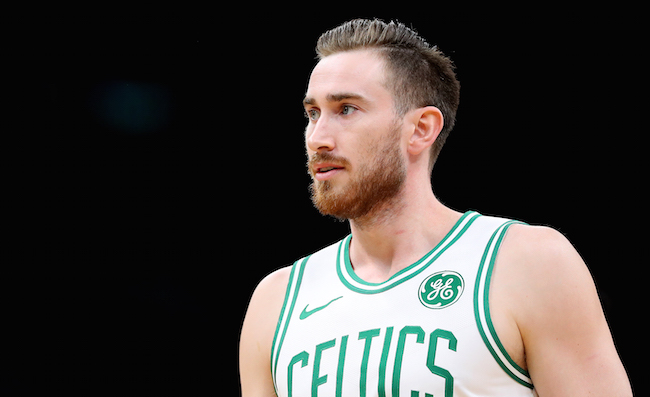
Reading into one game is a gigantic fool’s errand. It’s an awfully risky move to say 1/82th of the NBA season tells us XYZ about a team or player, but using it in the context of a much larger conversation can be helpful. For example: While the Celtics’ 128-95 win over Golden State at Oracle Arena on Tuesday night doesn’t tell us that the issues that have popped up in Boston this season are resolved and they turned a corner after losing five of their last six games, it did reinforce that they’re a completely different team when Gordon Hayward plays like a superstar.
Hayward was out of his mind against the Dubs, and considering the recent turmoil in Boston, it could not have came at a better time. The former All-Star forward saw 28 minutes of action off the bench, going for 30 points on 12-for-16 shooting with seven rebounds and four assists. His minutes were the most fruitful for the Celtics, too, as Hayward was a game-high +32.
“I understand it’s one game,” Hayward said, according to Tim Bontemps of ESPN. “You are going to have ups and downs in the season. I’ll try to build off the things I did correctly tonight, and the next time you have a bad game, try to learn from that one.”
Now of course, Hayward probably isn’t going to score 30 points in 28 minutes and shoot 75 percent from the field every game, because this is not a video game. It’s also probably a bit unfair to pin too many of Boston’s problems on him, because despite the max contract he signed last offseason, coming back from the sort of injury he suffered at the start of the 2017-18 season is physically and mentally really, really difficult.
Despite all of this, it’s not a stretch to say that the Celtics are a completely different team when they get the best version of Hayward. It’s a bit of a no-brainer statement — having an All-Star coming off the bench is a luxury that most teams would kill to have — but the splits between Good Gordon Hayward and Not So Good Gordon Hayward are striking.

According to NBA.com, Boston is 35-24 in games that Hayward plays, and regardless of the outcome of games, he’s playing a hair under 26 minutes a night. Still, the Hayward that shows up in wins and the Hayward that shows up in losses are two completely different basketball players: In wins, the Celtics have an offensive rating of 114.8, a defensive rating of 98.8, and a net rating of +16 with Hayward on the floor. In losses, the offensive rating tanks to 102.9, the defensive rating spikes to 110.6, and the net rating plummets to -7.7.
A popular saying is that the NBA is a make or miss league. This, too, is reinforced by Hayward, who has an effective field goal percentage of 57.9 percent and a true shooting percentage of 62.1 percent in wins. The former goes down to 38.5 percent and the latter drops to 44.4 percent in losses.
You can probably guess that a collection of Boston’s best players outside of him — Kyrie Irving, Al Horford, Jayson Tatum, Jaylen Brown, Marcus Smart — play worse in losses because, to state the obvious, a team’s best players normally don’t suck in wins and thrive in losses. The drop off, though, is more prominent with Hayward than anyone else, both in terms of team success and the individual’s ability to score the basketball.
The good news, though, is that when Hayward is at his best, he’s looked like the guy who earned a four-year deal worth nearly $128 million during the summer of 2017 and nearly caused a brawl to break out between all of Massachusetts and all of Utah. He’s also, generally, done a better job leading Boston’s bench unit as opposed to starting, and has thrived this season operating as the man among those groups.
Per Cleaning the Glass, the Irving-Brown-Hayward-Tatum-Horford lineup hasn’t played up to the sum of its parts, while the lineups that have Terry Rozier-Brown-Hayward-Daniel Theis and one of Tatum or Marcus Morris have had a better go of things, particularly on offense. The former is Boston’s most-used lineup with Hayward, with the latter lineup with Tatum coming in second and Morris coming in third. Here’s how they look:

This isn’t to say Hayward can’t play with Irving and Horford — Irving-Hayward-Tatum-Morris-Horford is annihilating teams on offense (147.6 points per 100 possessions) and is a perfectly fine defensive unit (106.5 points per 100 possessions) — but we have enough evidence to show that Brad Stevens’ most frequent deployment is with one other starter in either Tatum or Morris. When that happens, the Celtics, to put it plainly, look like a really, really good basketball team.
Boston has enough talent that this kind of a blanket statement won’t always apply, but we saw something on Tuesday night that we’ve seen all year. Hayward isn’t the Celtics’ best player, but when he’s coming off the bench and really cooking, it’s possible that he might be the difference between an earlier than expected exit from the playoffs and a championship-caliber team.






